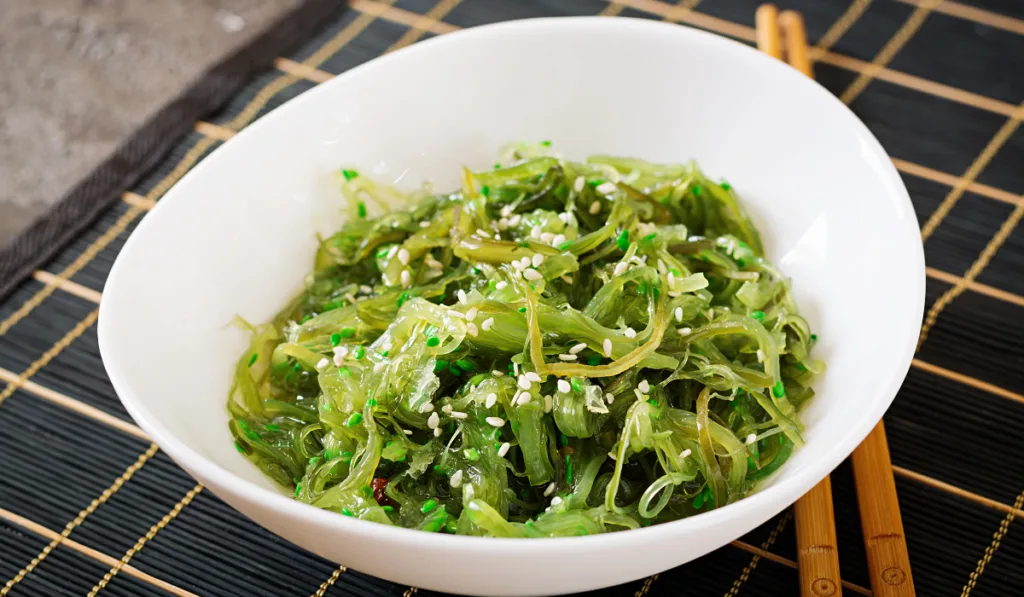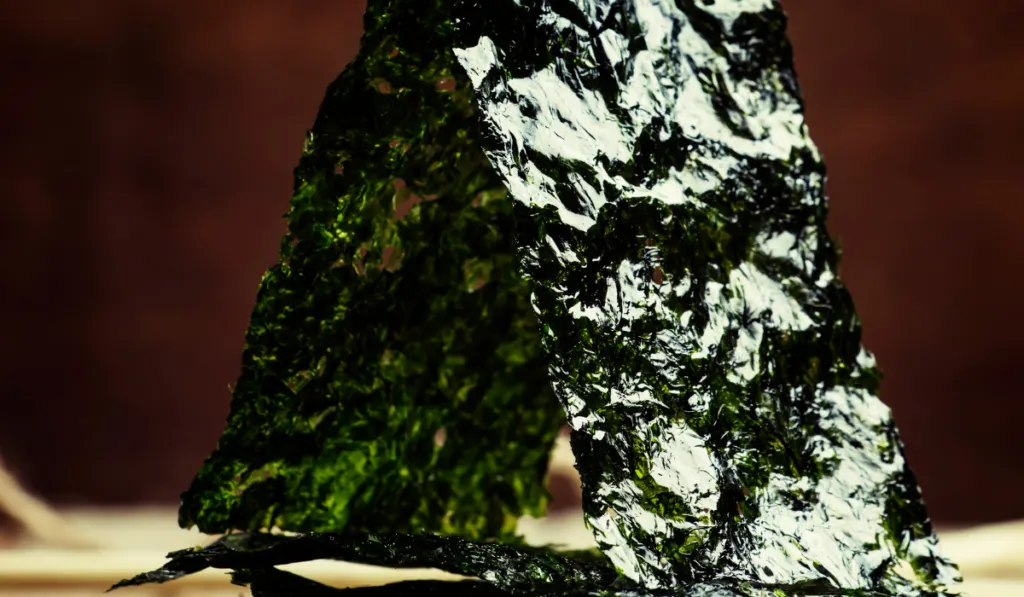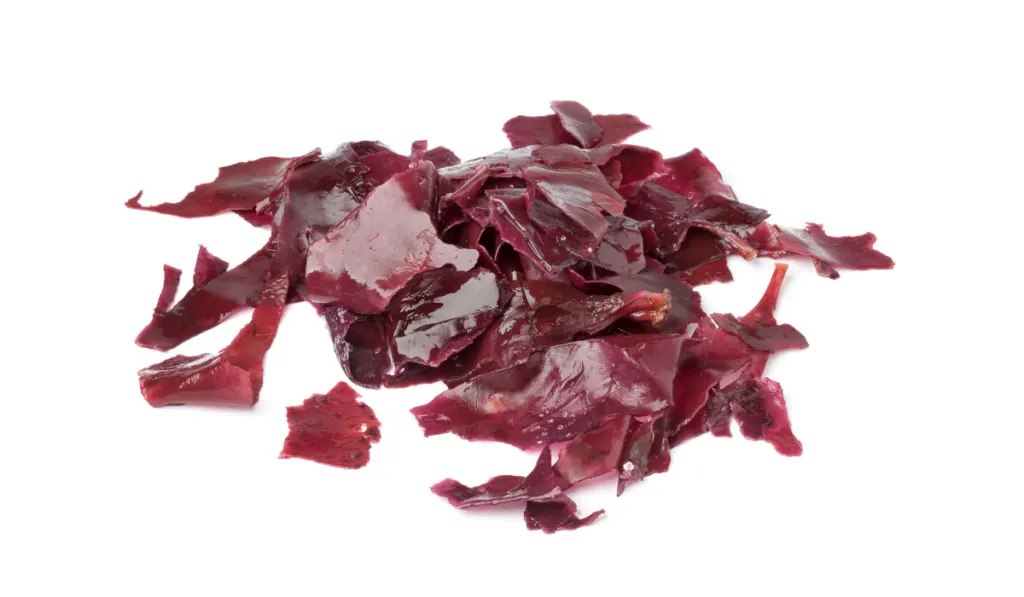In the 21st century, people are more interested in consuming highly nutritious foods than ever before. What a high time to introduce seaweed to your dinner table!
Whenever you think of seaweed, green sheets of nori used for sushi roll wrappings are most probably what comes to mind. But the aquatic life offers much more than just dried sushi wrappers. Like terrestrial weeds, seaweeds are full of nutrients and flavor, and so are considered superfoods.
Seaweeds have always been primary ingredients in many Asian cuisines, especially Japanese and Chinese, and have been harvested for over a millennium for culinary purposes. Today, seaweed is regularly used in smoothies, and the dried versions are fast gaining popularity in place of fries.
In this article, I have prepared a list of popular seaweeds, but first, let’s get some general seaweed information.

Table of Contents
What is a Seaweed?
Seaweed refers to the vast aquatic green life from tiny marine plants to large algae growing in water bodies. Some seaweed species can be small, while others form huge underwater forests. Seaweeds have historically been part of the food cultures of many coastal people.
They are known for their vast minerals, vitamins, and antioxidants, not to mention the elusive umami flavor, putting them in the superfood cluster.
What Color is Seaweed?
Seaweeds are mainly categorized in three colors; green, brown, and red. The darker and brown colors help the plants capture more light in deeper waters, but needless to say, all produce their foods through photosynthesis, although they will have varying nutritional contents.
Interestingly, the red and brown pigments often dissolve while others turn green whenever the seaweed is soaked or cooked. Here are examples of common seaweeds by color;
- Green seaweeds (Chlorophytes) – Umibudo, Sea Lettuce.
- Brown seaweeds (Phaeophytes) – Wakame, Arame, Kombu, Hijiki.
- Red seaweeds (Rhodophyta) – Nori, Irish moss, Bulse.

Where Are Edible Seaweeds Found?
Seaweeds are mainly found in their natural habitats of the marine environment. However, seaweed farming has gained fame and is producing most of the seaweeds found in the market today.
Most farmers use saltwater tanks to grow seaweeds. In contrast, others have sea plots equivalent to gardens out in the sea, where they use ropes to mark territory while closely monitoring and cultivating the growth of their seaweeds and removing other unwanted weeds for a superior harvest.
Is All Seaweed Edible?
No, not all types of seaweeds are edible. However, edible seaweeds often have a delicious flavor and texture. Also, keep in mind that any aquatic life will often absorb nutrients and pollutants from its surrounding environment altogether. So you should avoid those growing near harbors and stagnant water and instead forage for fresh seaweeds.
Is Seaweed Safe to Eat?
Although seaweed is safe for most people, some have high levels of potassium and iodine, which could be problematic for individuals with thyroid issues.
Hijiki has also been in the spotlight for having a significant amount of inorganic components, leading to nations like Canada issuing warnings limiting its consumption.
Types of Edible Seaweeds
1. Nori

Sometimes known as laver or green lettuce, nori is one of the most popular seaweeds today. It has a deep purplish-red color that turns dark green when dried.
The nori leaves are roasted, dried, and pressed into sheets for sushi rolls and rice balls (onigiri). Like most seaweeds, it has a salty, slightly sweet, briny, but also smoky flavor, which is well complemented by its crisp texture.
While some seaweeds often need to be reconstituted in freshwater, nori sheets can be used dry. You can also crunch them into a powder form (Aonori), which has a reputation for flavoring Japanese dishes such as yakisoba (buckwheat noodles) and okonomiyaki (pancakes).
Besides rolling sushi, nori is a great flavor enhancer for any vegan food if you want a taste of seafood. They can also make great salt substitutes for homemade spice-blends because of its salt content.
2. Wakame
Wakame, also called sea mustard, is a dark green seaweed that grows into huge and heavy aquatic forests. It does not only provide shelter and food for various marine life but is also a highly nutritious food fit for human consumption. Wakame is famously used in miso soup, small green squares, and salads.
Dried wakame looks dark and faded, but it assumes a green color and reveals its satiny texture once soaked. Wakame is sweet with a silky smooth texture and is rich in omega-3 fatty acids.
3. Dulse

Historically harvested in Iceland and Scotland over a millennium ago, dulse is a reddish seaweed native to the colder waters of the northern Pacific and Atlantic waters, where they grow attached to rocks.
Dulse can be used as a bacon substitute because of its soft and leathery texture with a salty and savory flavor. It can also be deep-fried in oil for a crispy snack or shredded, ground into powder, or sold in flakes for a wide array of culinary purposes, seasoning meat, making soups, or baking into chips.
Dulse can also be used for making compound butter, which is a blend of the flavor-filled dulse flakes with rich, creamy butter.
4. Kombu
Kombu, also konbu, is another type of sea kelp famously used for making the savory dashi broth, a staple soup foundation for most Japanese dishes. They have high levels of monosodium glutamate (MSG) compound, attributed to the rich umami flavor. Kombu can also be steeped in freshwater to make kombucha, a Japanese tea, or can be softened using hot water and served with Japanese rice wine (mirin) if you want to enjoy it by itself.
Dried Kombu may have a white powdery substance on the surface when unpackaged. This is crystallized MSG and should not be a source of alarm. It is safe to eat. However, if there is sand or any grit on the Kombu leaf surface, gently wipe it off with a soft cloth before using it.
5. Hijiki

Anciently found on the rocky shores of China, Korea, and Japan, hijiki is a brown seaweed that looks like little thin twigs that turn black when dried. They are first boiled and dried after harvesting and later served with fish or used for making stir-fries.
Hijiki has been under hot criticism for having inorganic compounds, so if you are worried about this, it’s best to avoid it.
6. Arame
This is another type of kelp seaweed. It has a feathery texture and is mainly hand-picked in Ise-Shima, a protected Japanese bay. After harvesting, arame fronds are shredded, dried, and packaged, looking like wispy black noodles. When cooked, arame has a mild, slightly sweet taste and is often used for salads, stir-fries, and noodle dishes.
Arame physically looks similar to hijiki, but arame is shredded while hijiki is stringy when dried. Arame is safe and can even be used in place of hijiki.
7. Irish Moss
Irish moss, also known as carrageen, is a purple/red alga mainly found on the Atlantic shores of Europe and the US. Irish moss is highly sought after for its high concentration of carrageenan. Carrageenan is the polysaccharide substance widely used as a thickening agent for desserts like ice cream and tapioca.
8. Umibudo (Seaweed Grapes)

Umibudo looks like a group of tiny green grapes. They are characterized by tiny green bubbles with pop and texture such as that of fish roe and have a sweet, salty, but slightly acidic taste. They can be served on their own with soy sauce or as a garnish for sushi, sashimi, and rice bowls.
Unfortunately, they are not widely available outside East Asia.
9. Sea Spaghetti
The name is coined from the looks of the spaghetti-like seaweed that grows in long ribbon blades, often stretching for several meters. It is highly nutritious but with a mild taste and can be used in place of spaghetti squash or in any meals that call for spaghetti. It can also be used for gluten-free pasta.
10. Sea Spinach or Sea Beet
Sea beet is arguably the mother of all spinach today, from beetroot to Swiss chard and many more. It has thick and leathery leaves, which are more succulent than terrestrial spinach, and can be used as a spinach supplement in almost any recipe.
Often found in challenging places, sea spinach is common in places with a salty sea breeze, cliffs, sea walls, and coastal footpaths. Sea spinach leaves can be harvested from late March through spring and summer.
Although you are supposed to cut them off, early stalks are often tender enough to cook with the rest of the vegetables. However, you should thoroughly wash and rinse off the leaf to remove any grittiness on the surface before cooking.

Other Edible Seaweeds
The list above is in no way an exhaustive list of all edible seaweeds available today. There are hundreds of seaweeds, others even unexplored if edible, but these are just the commonly known.
Other common edible seaweeds are the bladderwrack, sea kales, spirulina alga, and Klamath.
Conclusion
Now that you have the necessary information on edible seaweeds with all their characteristics have fun looking for and introducing them to your kitchen.
Resources
- https://www.webstaurantstore.com/blog/3940/types-of-edible-seaweed.html
- https://www.masterclass.com/articles/what-is-edible-seaweed#4-simple-seaweed-recipes
- https://www.finedininglovers.com/article/edible-seaweeds-you-should-try
- https://seaspoon.com/blogs/news/edible-seaweed
- https://www.downthecove.com/seaweed-foraging/
- https://www.sciencedirect.com/topics/agricultural-and-biological-sciences/edible-seaweed
